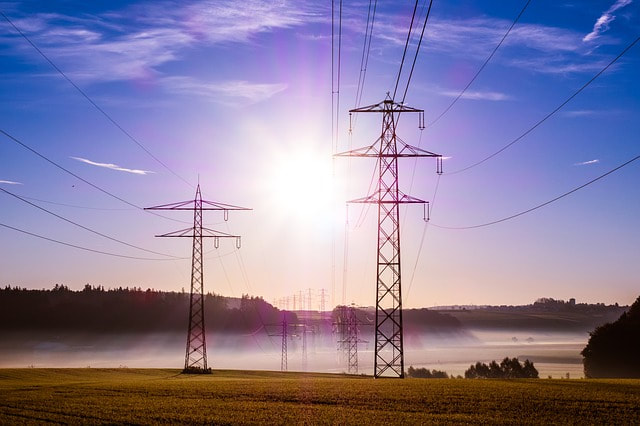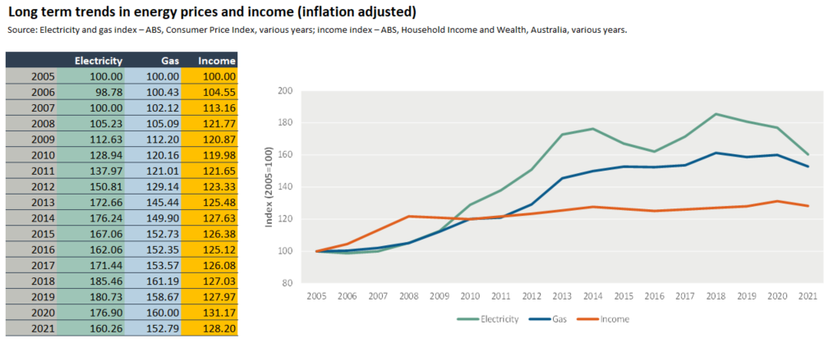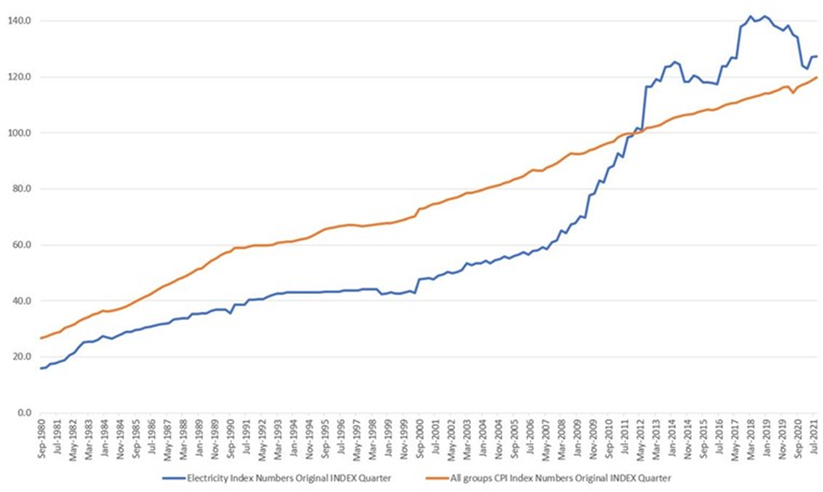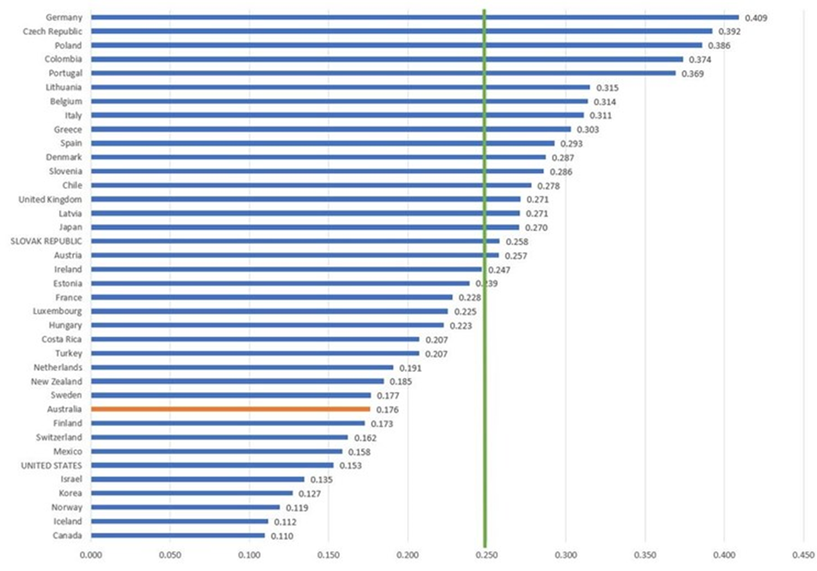|
This week we visit a topic that has been prominent in the headlines and one that has already got the new government on the backfoot. That is, the almost exorbitant rise in the price of utilities for the Australian consumer. More importantly for the investor, this has implications on inflation data (and monetary policy imperatives as a result). Given the politicisation of the topic in recent years, some context is important here. We would argue that very few consumers understand the actual framework and operational environment that results in their power bills. How The Energy Market Actually Works: A Layman’s ExplanationBroadly speaking the process of getting electricity into your home and/or business can be simplified into four distinct steps:
There is perhaps a fifth category that has become increasingly important in recent years and that is the adoption of rooftop solar and photovoltaics (PV) which can bring on additional capacity to the grid. With that simple schema we move to add on a little more complexity by looking at the assorted stakeholders through the process. First, the generation of power itself, this is one aspect that you may be most familiar with: the source of the generation itself. These sources can broadly be categorized as fossil fuels based (e.g. thermal coal & natural gas) and renewables (e.g. wind, solar or hydro). However, generating the electricity is not in itself the end, there has to be a way for consumers to purchase said electricity and here is where the retailers come in. The retailers purchase the electricity from the generators through a common wholesale market called the National Energy Market (NEM). They then need to use transmission infrastructure to bring the electricity to the consumer and here is where the other stakeholder enters. In Australia, the national infrastructure is managed by the Australian Energy Markets Operator (AEMO). The distribution networks themselves are owned by a jumble of entities, some private (in the case of Ausgrid, on a 99 year lease from NSW) and others public. So, we have the beginnings of understanding the utilities market. We then move on to the next piece of the puzzle, the regulatory apparatus. Utilities, given their exceptionally high barriers to entry and centrality to the overall economy, are intrinsically regulated sectors; the vast amount of capital expenditure essentially making them natural oligopolies (in economics we term this as market failure). What then is the fundamental issue that these regulators are trying to solve? Firstly, given structural barriers to entry and the oligopolistic nature of the environment, there is a natural tendency for operators to resort to rent-seeking (or above normal profits) in the absence of oversight. What the regulatory apparatus broadly seeks to achieve is to ensure price stability while balancing out long-term sustainability of infrastructure (more on this later). The agencies, independent like the RBA, relevant here are the Australian Energy Market Commission (AEMC), The Australian Energy Regulator (AER, part of the ACCC) and finally the Australian Energy Markets Operator. The AEMC is perhaps the most important of these when it comes to power bills. It does this through effectively setting price floors (the lowest price that can be paid in the wholesale market) and price caps (that is the highest rate that can be paid). Further, the commission’s other primary tool is the DMO, or Default Market Offer, mechanism which is the annual maximum total bill that energy companies can charge for the ‘standing offer’ prices based on a set average user amount. It must be remembered that the latter, while often misconstrued as a price cap, is a reference price and depends on total usage. So herein lies the first important point, the overall profitability of the utilities sector is based on the above set of factors. First, the wholesale price or the price they are able acquire a given unit of electricity for and the DMO. Alternatively, large retailers could enter into longer term contracts with generators to fix the price of supply. How the wholesale spot market functions: Generators offer to supply the market with a certain amount of electricity for a particular price, and AEMO accepts these, starting with the cheapest and working its way up to the more expensive until demand has been met. Renewables are usually available first given their relative low cost availability. The process occurs every five minutes. The highest offer that AEMO accepts from a generator is then set as the ‘dispatch price’ for that period and, over the course of every thirty minutes, six dispatch prices are averaged to determine spot price for each region. The maximums currently set by the National Electricity Rules (which are adjusted for inflation) are $15,000/MWh. So if we can accept that at the end of the day, prices can largely be said to be a function of regulation, this brings us to another question. Namely, how do regulators determine the pricing? Determining the DMOWe mentioned above that the regulatory apparatus is effectively trying to balance two opposing objectives, maintaining the stability and sustainability of the overall market while at the same time ascertaining the lowest end price. The former incentivised by economic profitability while the latter implies the opposite. In order to do this the AEMC uses a multi-pronged framework. The first aspect relies on the actual costs incurred by the retailers to supply customers. This includes purchase (wholesale costs), transport (network costs), the costs of government environmental schemes (environment costs) and costs associated with serving retail customers (i.e. billing, provision of hardship services etc). This is then offset against what the ACCC determines as a justifiable level of profitability that 1) incentivises further investment; and 2) keeps existing operators healthy. It is within this context that the AEMC came out with its recent announcement that made such headlines: the substantial increase in the price caps that could potentially see NSW customers paying an additional 2.9 - 12.1% above expected inflation. Customers in QLD potentially seeing 5.5 – 6.8% above expected inflation and residential customers in South Australia facing increases above expected inflation of 1.7% - 3.8%. This should be taken in context of the below chart and data, which actually demonstrates a decrease in prices between 2013 and 2021 (despite all the hysterical headlines). So, what has warranted this step in prices for 2022? The RationaleQuite frankly we find much of the political debate quite bizarre. As elucidated by the AEMC itself, the single most important factor behind the overall increase has been inflation in wholesale costs. At the time of writing, wholesale prices have increased to the tune of 120-140% in twelve months. With environmental regulatory expenses, such as small-scale renewable energy scheme certificates and slight increases in NSW environment costs, playing an explicitly negligible role in the decision while transmission costs have pulled in the opposite direction (falling slightly). The prices of both gas (with increased demand for exports to Asia) and coal have created a somewhat perfect storm for an already stretched supply side since the beginning of the year. The graph below showcases the extent to which energy (Electricity Index) inflation has run more aggressively than overall CPI. This comes in stark contrast to the last three years where the drastic reductions in wholesale prices meant that Australia saw declines over the same period. This was combined with legislation passed in late 2020 that effectively mandated that reductions in wholesale costs be passed on to consumers (i.e. Treasury Laws Amendment – Prohibiting Energy Market Misconduct 2019). In fact, among the OECD countries, Australia has the 10th lowest household expenditure to utilities. So, what has changed in the wholesale markets? Wholesale Markets
UNSW Newsroom, September 2021: Are solar and wind the cheapest forms of energy? And other FAQs about renewables CSIRO, December 2020: Renewables still the cheapest new-build power in Australia Take the example of solar, weather and time dependent, working at peak capacity during the middle of the day. The excess supply during these times has meant that it has increased the volatility of the spot market. So much so that it has had the perverse impact of making coal generators, exposed to far greater variations in price in the middle of the day, financially unstable (spot prices often go negative at certain times). The failure has been the lack of investment into storage capacity that evens out the flow as opposed to the bringing on of additional supply, which inevitably creates downward pressure. Such instability has meant that over the next two decades, sixteen gigawatts (GW) of thermal generation, 61% of the current coal fleet, is expected to retire. And, while the previous government consistently moved to jawbone the market, the economics and financial metrics have ensured that there is very little appetite from the private sector to take on the associated risks when, at the same time, technological advancement and uptake in storage, hydrogeneration and household batteries creates a massive question mark over any new long-term capex within the more traditional elements of the sector. Simply put, who would be willing to finance a project on a thirty year timeframe when the whole thing is likely redundant within fifteen? All this has also meant that wholesale markets have unfortunately been caught up in the cross-winds of global events. That is to say, the energy mix hadn’t changed quickly enough and the recent volatility in global energy markets (starting with the Russia-Ukraine war) has meant that we were exceptionally vulnerable despite an abundance in said resources. In essence, the unrelenting demand and associated rise in the price of both coal and gas has meant deficits domestically while at the same time the transition to and increased market share of renewables has created financial stress for existing generators. This is an economic issue that has somehow become a question of political ideology, a rather bizarre scenario that continues to baffle. There has unfortunately been neither consistency nor clarity from Canberra as to how to grapple with an industry in transition. It seems that policy makers still wish to direct the sector while expecting (profit motivated) private players to make financially illiterate decisions on long-term capex. This all comes with the added challenge of legislative gymnastics every three years (despite Liberal leadership for the best part of a decade, even they about faced on things like emissions trading). This was short sightedness at its best, the historic and unprecedented declines in the price of energy over the past decade had incentivised a tendency to keep to the status quo with no regard for the overall stability of the grid. Where To Next? Implications For Inflation?Many will be well aware of our view on peak-oil and, by extension, traditional fossil fuels as the transition occurs (i.e. no new supply and existing demand). Ironically, this may lead to what is termed demand destruction, i.e. the price remains high enough that alternatives are fast tracked. This was perhaps the reason why OPEC, using the oil market as an analogy, has consistently tried to maintain a band for the spot price and didn’t actively push for triple digits. Supply issues seem to have got ahead of them now, the same can be said for both coal and gas. This will inevitably have an impact on short-run CPI data given the weighting toward energy prices in the data. From here we must ask what the implications are for monetary policy. This may not be straightforward. For one thing, in coming up with the decision and justifying the increase in DMO, AEMC also elucidated upon another titbit of information on hardship customers, electricity debt reached record levels in 2020 and has not relented. Up to that point they were around 58% higher than December 2018. This is not an indication of a strong consumer by any stretch of the imagination. This inflationary pressure is not demand driven but rather supply driven. Using monetary policy too aggressively in this circumstance is the worst form of policy error in our view. This is a sector in transition and the price action should not be blown out of proportion, the increases come after three years of consecutive declines. Increases to the cost of capital in an already struggling sector could have disastrous consequences. In other words, this might be one area where last years favourite phrase of central bankers about inflation being transitory might just be applicable. Next week we look at a rather topical example relating to what we have covered above: AGL (AGL.ASX).
1 Comment
John
17/6/2022 03:31:01 pm
An excellent article that clarifies many of the arcane issues that so perplex the average punter, like me.
Reply
Your comment will be posted after it is approved.
Leave a Reply. |
Markets & CommentaryAt TAMIM we are committed to educating investors on how best to manage their retirement futures. Sign up to receive our weekly newsletter:
TAMIM Asset Management provides general information to help you understand our investment approach. Any financial information we provide is not advice, has not considered your personal circumstances and may not be suitable for you.
Archives
April 2024
Categories
All
|
TAMIM | Equities | Property | Credit
DISCLAIMER
The information provided on this website should not be considered financial or investment advice and is general information intended only for wholesale clients ( as defined in the Corporations Act). If you are not a wholesale client, you should exit the website. The content has been prepared without taking into account your personal objectives, financial situations or needs. You should seek personal financial advice before making any financial or investment decisions. Where the website refers to a particular financial product, you should obtain a copy of the relevant product services guide or offer document for wholesale investors before making any decision in relation to the product. Investment returns are not guaranteed as all investments carry some risk. The value of an investment may rise or fall with the changes in the market. Past performance is no guarantee of future performance. This statement relates to any claims made regarding past performance of any Tamim (or associated companies) products. Tamim does not guarantee the accuracy of any information in this website, including information provided by third parties. Information can change without notice and Tamim will endeavour to update this website as soon as practicable after changes. Tamim Funds Management Pty Limited and CTSP Funds Management Pty Ltd trading as Tamim Asset Management and its related entities do not accept responsibility for any inaccuracy or any actions taken in reliance upon this advice. All information provided on this website is correct at the time of writing and is subject to change due to changes in legislation. Please contact Tamim if you wish to confirm the currency of any information on the website.
magellen, kosec, clime, wilson, wam, montgomery, platinum, commsec, caledonia, pengana, tamim





 RSS Feed
RSS Feed